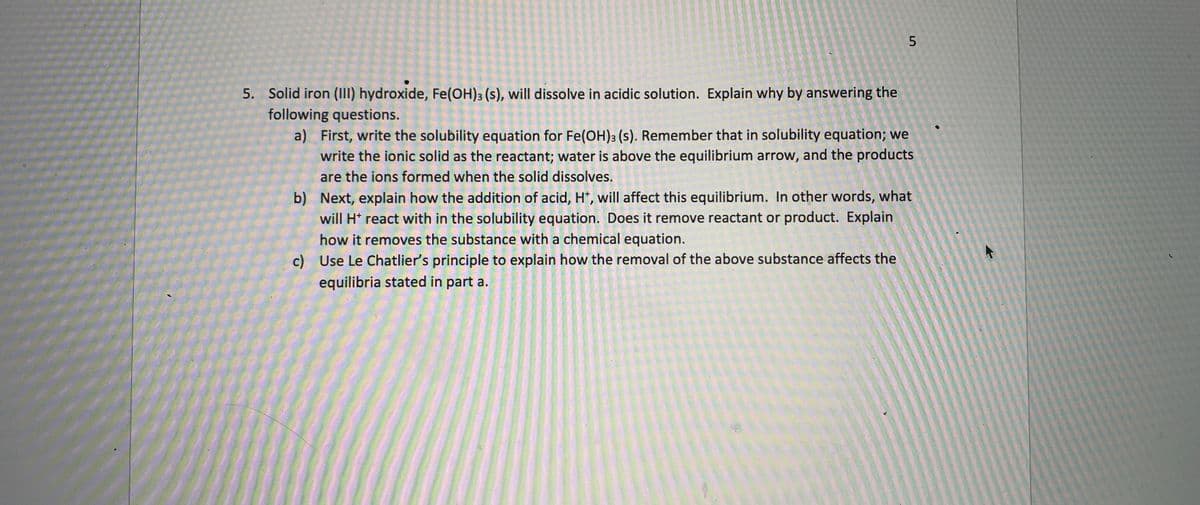5 5. Solid iron (III) hydroxide, Fe(OH)3 (s), will dissolve in acidic solution. Explain why by answering the following questions. a) First, write the solubility equation for Fe(OH)3 (s). Remember that in solubility equation; we write the ionic solid as the reactant; water is above the equilibrium arrow, and the products are the ions formed when the solid dissolves. b) Next, explain how the addition of acid, H+, will affect this equilibrium. In other words, what will H* react with in the solubility equation. Does it remove reactant or product. Explain how it removes the substance with a chemical equation. c) Use Le Chatlier's principle to explain how the removal of the above substance affects the equilibria stated in part a.
5 5. Solid iron (III) hydroxide, Fe(OH)3 (s), will dissolve in acidic solution. Explain why by answering the following questions. a) First, write the solubility equation for Fe(OH)3 (s). Remember that in solubility equation; we write the ionic solid as the reactant; water is above the equilibrium arrow, and the products are the ions formed when the solid dissolves. b) Next, explain how the addition of acid, H+, will affect this equilibrium. In other words, what will H* react with in the solubility equation. Does it remove reactant or product. Explain how it removes the substance with a chemical equation. c) Use Le Chatlier's principle to explain how the removal of the above substance affects the equilibria stated in part a.
Chemistry: An Atoms First Approach
2nd Edition
ISBN:9781305079243
Author:Steven S. Zumdahl, Susan A. Zumdahl
Publisher:Steven S. Zumdahl, Susan A. Zumdahl
Chapter12: Chemical Equilibrium
Section: Chapter Questions
Problem 9RQ: What is Le Chteliers principle? Consider the reaction 2NOCI(g)2NO(g)+Cl2(g) If this reaction is at...
Related questions
Question

Transcribed Image Text:5
5. Solid iron (III) hydroxide, Fe(OH)3 (s), will dissolve in acidic solution. Explain why by answering the
following questions.
a) First, write the solubility equation for Fe(OH)3 (s). Remember that in solubility equation; we
write the ionic solid as the reactant; water is above the equilibrium arrow, and the products
are the ions formed when the solid dissolves.
b) Next, explain how the addition of acid, H+, will affect this equilibrium. In other words, what
will H* react with in the solubility equation. Does it remove reactant or product. Explain
how it removes the substance with a chemical equation.
c) Use Le Chatlier's principle to explain how the removal of the above substance affects the
equilibria stated in part a.
Expert Solution
This question has been solved!
Explore an expertly crafted, step-by-step solution for a thorough understanding of key concepts.
This is a popular solution!
Trending now
This is a popular solution!
Step by step
Solved in 2 steps

Recommended textbooks for you

Chemistry: An Atoms First Approach
Chemistry
ISBN:
9781305079243
Author:
Steven S. Zumdahl, Susan A. Zumdahl
Publisher:
Cengage Learning


Chemistry by OpenStax (2015-05-04)
Chemistry
ISBN:
9781938168390
Author:
Klaus Theopold, Richard H Langley, Paul Flowers, William R. Robinson, Mark Blaser
Publisher:
OpenStax

Chemistry: An Atoms First Approach
Chemistry
ISBN:
9781305079243
Author:
Steven S. Zumdahl, Susan A. Zumdahl
Publisher:
Cengage Learning


Chemistry by OpenStax (2015-05-04)
Chemistry
ISBN:
9781938168390
Author:
Klaus Theopold, Richard H Langley, Paul Flowers, William R. Robinson, Mark Blaser
Publisher:
OpenStax

Introductory Chemistry: A Foundation
Chemistry
ISBN:
9781337399425
Author:
Steven S. Zumdahl, Donald J. DeCoste
Publisher:
Cengage Learning

Chemistry for Engineering Students
Chemistry
ISBN:
9781337398909
Author:
Lawrence S. Brown, Tom Holme
Publisher:
Cengage Learning

Introductory Chemistry: A Foundation
Chemistry
ISBN:
9781285199030
Author:
Steven S. Zumdahl, Donald J. DeCoste
Publisher:
Cengage Learning